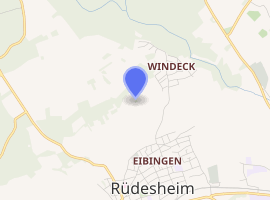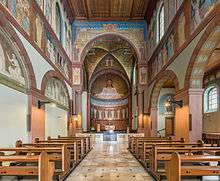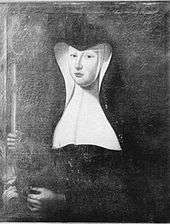Eibingen Abbey
Eibingen Abbey (German: Abtei St. Hildegard, full name: Benedictine Abbey of St. Hildegard) is a community of Benedictine nuns in Eibingen near Rüdesheim in Hesse, Germany. Founded by Hildegard of Bingen in 1165, it was dissolved in 1804, but restored, with new buildings, in 1904. The nuns produce wine and crafts. They can be heard singing their regular services, which have been at times recorded. The church is also used as a concert venue. The abbey is a Rhine Gorge World Heritage Site.
| Eibingen Abbey Abtei St. Hildegard | |
|---|---|

| |
| 49°59′33″N 7°55′41″E | |
| Location | Eibingen, Germany |
| Denomination | Catholic |
| Architecture | |
| Style | Romanesque revival |
| Groundbreaking | 1900s |
| Administration | |
| Diocese | Diocese of Limburg |
| Official name | Upper Middle Rhine Valley |
| Type | Cultural |
| Criteria | ii, iv, v |
| Designated | 2002 |
| Reference no. | 1066 |
| Region | Europe and North America |

History
The original community was founded in 1165 by Hildegard of Bingen. This was the second community founded by her. It was disestablished in 1804.[1] After the Reichsdeputationshauptschluss (German mediatization), the land once owned by the convent became part of the domains of the prince of Nassau-Weilburg who, in 1831, even bought both the monastery and its church.
The community was reestablished by Charles, 6th Prince of Löwenstein-Wertheim-Rosenberg in 1904 and resettled from St. Gabriel's Abbey, Bertholdstein. The nunnery belongs to the Beuronese Congregation within the Benedictine Confederation.[1] A new building was erected in Neo-Romanesque style. In 1941, the nuns were expelled by the Nazis; they were not able to return until 1945. In 1988, the sisters founded Marienrode Priory at Hildesheim, which became independent of Eibingen in 1998.
The nuns work in the vineyard and in the craft workshops, besides undertaking the traditional duties of hospitality. A visitor watched the nuns using GPS systems, computers and modern kitchen tools.[2] They can be heard (but not seen) singing their regular services. The nuns have recorded their Vespers,[3] which they perform every day.[4] A first recording was made in 1973 and contained only two works by Hildegard of Bingen, a Kyrie and O virga ac diadema. A second recording appeared in 1979, to remember the 800th anniversary of Hildegard's death, including the same pieces and antiphones, a hymn, a responsory and parts of Ordo virtutum. In 1989, a third recording appeared, conducted by P. Johannes Berchmans Göschl, a scholar of Gregorian chant.[5] A reviewer of Gramophone noted about a 1998 recording: "These nuns are living the same life as that of Hildegard's community, singing daily the same Benedictine Office, breathing the same air and trying to capture the spirit of their great twelfth-century predecessor."[6]
Abbesses
- Hildegard of Bingen (1098–1179), first abbess and founder of the community
From 1603 the abbesses held the title of "Abbess of Rupertsberg and Eibingen".
- Kunigunde Frey von Dehrn, abbess around 1600
- Anna Lerch von Dirmstein, abbess until 1666
- Kunigunde Schütz von Holtzhausen, abbess from 1666 to 1669
- Scholastica von Manteuffel, abbess from 1670
- Maria Antonetta Mühl zu Ulmen, abbess from 1711

- Philippine zu Guttenberg, last abbess from 1790 to 1804.
Since the re-establishment of the community in 1904:
- Regintrudis Sauter, abbess from 1908 to 1955
- Fortunata Fischer, abbess from 1955 to 1978
- Edeltraut Forster, abbess from 1978 to 1998
- Gisela Happ, prioress from 1998 to 2000
- Clementia Killewald, abbess from 2000 to 2016
- Dorothea Flandera, abbess from 2016
Heritage
The abbey is a Rhine Gorge World Heritage Site.[7] The church has been used for concerts of the Rheingau Musik Festival, such as a "BachTrompetenGala" with organist Edgar Krapp[8] and a concert with the New York Polyphony in 2014.[9] The sculptor Karlheinz Oswald made in 1998 a life-size bronze statue called Hildegard of Bingen, with one copy in the Bingen museum, another in the garden in front of the abbey church.
References
- "Eibingen (Abtei St. Hildegard)" (in German). orden-online.de. Retrieved 4 November 2016.
- Derkse, Wil; Kessler, Martin (2003). The Rule of Benedict for Beginners: Spirituality for Daily Life. Liturgical Press. pp. 2–3. ISBN 9780814628027. Retrieved 17 November 2016.
- Lewis, Uncle Dave. "Benedictine Nuns of St. Hildegard / Hildegard von Bingen: Vespers from the Abbey". AllMusic. Retrieved 17 November 2016.
- "Gottesdienstzeiten" (in German). abtei-st-hildegard.de. Retrieved 17 November 2016.
- Bain, Jennifer (2003). The Rule of Benedict for Beginners: Spirituality for Daily Life. Liturgical Press. pp. 30–3. ISBN 9780814628027. Retrieved 17 November 2016.
- "Hildegard von Bingen Vespers". Gramophone. Retrieved 17 November 2016.
- "The Abbey of St. Hildegard". World Heritage. Archived from the original on 19 July 2011. Retrieved 4 November 2016.
- "Abtei St. Hildegard, Eibingen". Rheingau Musik Festival. Archived from the original on 24 May 2012. Retrieved 4 November 2016.
- "Rheingau Musik Festival presents New York Polyphony". newyorkpolyphony.com. 4 July 2014. Retrieved 17 November 2016.
External links
| Wikimedia Commons has media related to Kloster Eibingen. |
- Official website
- Hildegardisvesper Vespers from Eibingen Abbey, YouTube, 20 September 2011
- The Hildegard of Bingen Trail in Germany spiritualtravels.info
- Sites › Rüdesheim › Abbey St. Hildegard landderhildegard.de
- Eibingen, Germany: Benedictine Abbey of Eibingen (Saint Hildegard of Bingen) thecatholictravelguide.com
- Gregor Kollmorgen: St. Hildegard Abbey newliturgicalmovement.org 11 November 2010